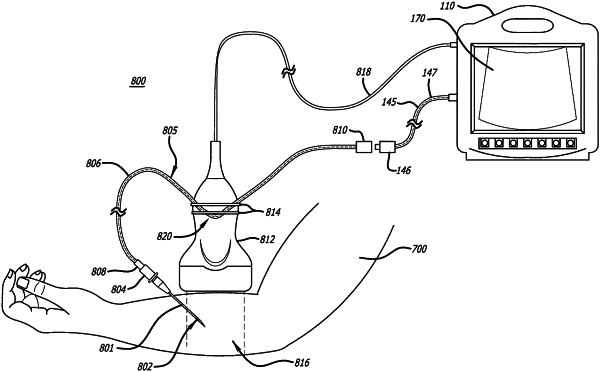| CPC A61B 34/20 (2016.02) [A61B 17/3403 (2013.01); A61B 34/25 (2016.02); A61B 2017/3405 (2013.01); A61B 2017/3413 (2013.01); A61B 2034/2061 (2016.02); A61B 2090/378 (2016.02)] | 19 Claims |

|
1. A medical instrument system for inserting a medical instrument within a patient body, the system comprising:
the medical instrument comprising a first optical fiber having one or more core fibers;
an interconnect including a second optical fiber having one or more core fibers, the second optical fiber extending along a length of the interconnect, wherein:
a distal end of the second optical fiber is optically coupled with a proximal end of the first optical fiber, and
a predetermined bend is formed in the interconnect including the second optical fiber at a point along the length of the interconnect; and
a console optically coupled to a proximal end of the interconnect including the second optical fiber, the console including one or more processors and a non-transitory computer-readable medium having stored thereon logic, when executed by the one or more processors, causes operations including:
providing an incident light signal to the first optical fiber and the second optical fiber,
receiving reflected light signals of different spectral widths of the incident light signal from the first optical fiber and the second optical fiber,
processing the reflected light signals to determine a positioning and an orientation of the medical instrument relative to the predetermined bend,
generating a display of the medical instrument based on the reflected light signals and the determination of the positioning and the orientation of the medical instrument relative to the predetermined bend, and
causing rendering of the display of the medical instrument on a display screen.
|
|
11. A medical instrument system for inserting a medical instrument within a patient body, the system comprising:
the medical instrument comprising a first optical fiber having one or more core fibers;
an interconnect including a second optical fiber having one or more core fibers, the second optical fiber extending along a length of the interconnect, wherein a distal end of the interconnect including the second optical fiber is optically coupled with a proximal end of the medical instrument including the first optical fiber, and wherein a portion of the interconnect includes a predetermined bend; and
a console optically coupled to the medical instrument, a proximal end of the interconnect including the second optical fiber optically coupled to the console, the console including one or more processors and a non-transitory computer-readable medium having stored thereon logic, when executed by the one or more processors, causes operations including:
providing an incident light signal to the first optical fiber,
receiving reflected light signals of different spectral widths of the incident light signal from the first optical fiber,
processing the reflected light signals to determine a positioning and an orientation of the medical instrument,
generating a display of the medical instrument based on the reflected light signals and the determination of the positioning and the orientation of the medical instrument, and
causing rendering of the display of the medical instrument on a display screen.
|
|
16. A medical instrument system for inserting a medical instrument within a patient body, the system comprising:
the medical instrument comprising a first optical fiber having one or more core fibers;
an interconnect including a second optical fiber having one or more core fibers, the second optical fiber extending along a length of the interconnect, where a distal end of the interconnect including the second optical fiber is optically coupled with a proximal end of the medical instrument including the first optical fiber;
a console optically coupled to the medical instrument, a proximal end of the interconnect including the second optical fiber optically coupled to the console, the console including one or more processors and a non-transitory computer-readable medium having stored thereon logic, when executed by the one or more processors, causes operations including:
providing an incident light signal to the first optical fiber,
receiving reflected light signals of different spectral widths of the incident light signal from the first optical fiber,
processing the reflected light signals to determine a positioning and an orientation of the medical instrument,
generating a display of the medical instrument based on the reflected light signals and the determination of the positioning and the orientation of the medical instrument, and
causing rendering of the display of the medical instrument on a display screen; and
an ultrasound probe coupled to the console via an ultrasound connection, wherein a portion of the interconnect that includes a predetermined bend is coupled to the ultrasound probe.
|